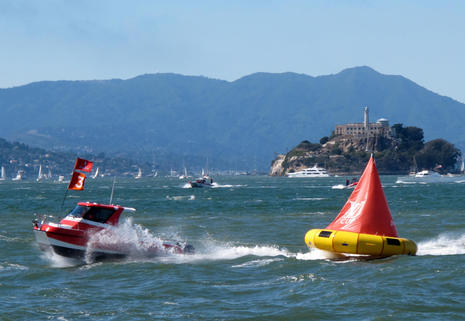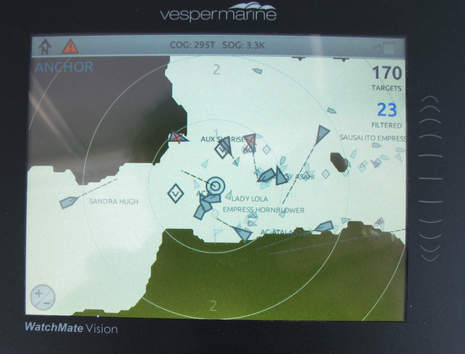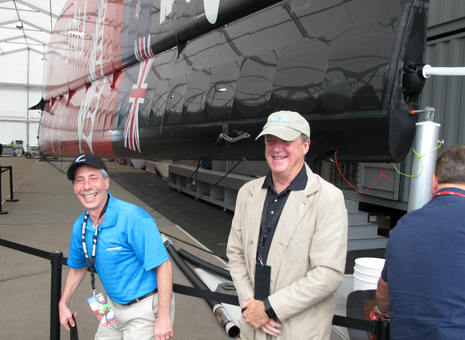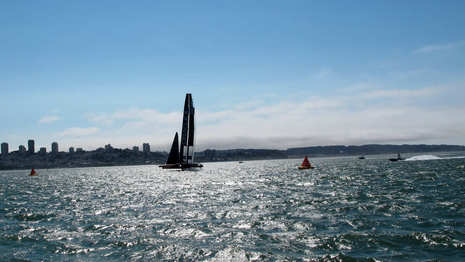Geeks win America’s Cup 34, Larry E. & Oracle Team USA also
 “Pretty cool…ESPN says one of the greatest upsets in sports history!” my brother-in-law emailed me last night, and he’s a guy who knows who pitched World Series games decades ago and how well, but bupkis about the America’s Cup. Yes, indeed, AC34 was incredibly unpredictable and exciting, but I’ll argue that the winners all along were the teams who made the race management, umpiring, and broadcasting so innovative and so effective…
“Pretty cool…ESPN says one of the greatest upsets in sports history!” my brother-in-law emailed me last night, and he’s a guy who knows who pitched World Series games decades ago and how well, but bupkis about the America’s Cup. Yes, indeed, AC34 was incredibly unpredictable and exciting, but I’ll argue that the winners all along were the teams who made the race management, umpiring, and broadcasting so innovative and so effective…
Consider, for instance, those huge floating race marks that showed up so well on TV and must have been easily visible to the racers even as they flew at 40 knots with gale-like spray in their faces. Remember that they were supposed to be 42-foot mark/VIP boats (Dan’s Panbo profile here) with Volvo Penta dynamic positioning so that race management could modify the course easily. Well, “easily” if you’ve put together amazing telemetry and data communications systems and the ability to push course changes out specially modified Garmin chartplotters on all the support vessels (Panbo committee boat visit here).
But the Artemis accident forced new safety measures including the decision not to put humans at the race marks, and AC Race Management (ACRM) apparently designed, sourced and built those floaters in three weeks. They are, in fact, giant megayacht-toy-style inflatable trampolines equipped with some sort of pyramid structure and a telemetry/comms pack so that ACRM, the umpires, and the LiveLine coverage would all know precisely where they were. I’m told that they’re quite comfortable inside, but a bitch to anchor and/or move in San Francisco Bay.
 Nonetheless, a few nattering nabobs of negativity at Sailing Anarachy still complained about how the ACRM aboard Regardless (above) could have changed the course, so that some of the cancelled races had run. But note who didn’t complain about the race management or the umpiring. The racers themselves neither complained nor argued, and I think that’s one key to why this event was so compelling (though perhaps not obvious unless you’ve suffered through contentious AC events).
Nonetheless, a few nattering nabobs of negativity at Sailing Anarachy still complained about how the ACRM aboard Regardless (above) could have changed the course, so that some of the cancelled races had run. But note who didn’t complain about the race management or the umpiring. The racers themselves neither complained nor argued, and I think that’s one key to why this event was so compelling (though perhaps not obvious unless you’ve suffered through contentious AC events).
So how about a big hand to AC34 uber geek Stan Honey (Panbo profile here) and team members like Eric Steinberg (Panbo profile here) and many others?
 You may notice that most of my writing about AC34 dates back to the ACWS event in San Diego almost two years ago (thanks again, Garmin). However, it’s largely the same tech team who ran the AC72 series in San Francisco and they clearly had their systems down. Heck, the umpires didn’t even need Eric’s tricked-out PWCs anymore, and I never once saw the impossibly complex Liveline overlays go out of register with the real and fast action on the Bay. (While the system wasn’t very useful in the fog, in my book that was only validation that Honey is not actually a god and was genius to keep the Virtual Eye system in reserve 😉
You may notice that most of my writing about AC34 dates back to the ACWS event in San Diego almost two years ago (thanks again, Garmin). However, it’s largely the same tech team who ran the AC72 series in San Francisco and they clearly had their systems down. Heck, the umpires didn’t even need Eric’s tricked-out PWCs anymore, and I never once saw the impossibly complex Liveline overlays go out of register with the real and fast action on the Bay. (While the system wasn’t very useful in the fog, in my book that was only validation that Honey is not actually a god and was genius to keep the Virtual Eye system in reserve 😉
Before I got to visit the ETNZ compound two weeks ago, ACRM had not only dealt with issues like the floating marks, but had also added goodies to the system like those virtual AIS spectator boundary buoys seen on the Vesper Vision screen above…
 The giggling geeks above are myself and Vesper founder Jeff Robbins (and note the video and audio microwave link antenna at the top of ETNZ’s wing). Jeff had worked with Stan Honey so that a single Vesper virtual AIS beacon transmitter (Panbo detail here) could not only place a row of virtual beacons along the spectator “fence”, but Stan’s course management system could automatically move them if and exactly when the course changed.
The giggling geeks above are myself and Vesper founder Jeff Robbins (and note the video and audio microwave link antenna at the top of ETNZ’s wing). Jeff had worked with Stan Honey so that a single Vesper virtual AIS beacon transmitter (Panbo detail here) could not only place a row of virtual beacons along the spectator “fence”, but Stan’s course management system could automatically move them if and exactly when the course changed.
There are many AC34-happy geeks around. At the NMEA Conference exhibit hall opening last night, for instance, the USCG’s AIS guy, Jorge Arroyo, was excited to talk about the virtual beacons and also the AIS-transmitted geographical boundary notice that Robbins and Honey trailblazed for the USCG (unlike the virtual beacons, most AIS displays — even Vesper’s — couldn’t see the lines, but they were there). Jim Dodez was also excited to talk about KVH’s several contributions to the Honey system and how it may have value beyond future sailboat racing.
All of this is not to say that Larry Ellison and Team Oracle didn’t do outstanding work. This is how I ended my Yachting article about AC34 technology and I planned to quote it even if Oracle had lost.
Larry Ellison may be one of the most competitive guys on earth, but wouldn’t a second Cup victory be sweetest if won on an ultrafair playing field in front of a huge crowd? In fact, I think Ellison may become a boating hero, not for winning the Cup once, twice or more, but for making it a truly great sporting event.
Finally, here’s a shot of Oracle beautifully losing race 2 on Sept. 12, when I was not the only one who thought that New Zealand had the Cup wrapped up – deservedly, too. I hope you agree that Larry and his teams of sailors and geeks still would have been winners.














We booked 49 mph on a Simrad demo boat today (and saw some neat stuff I can’t write about yet). That feels darn fast even behind a T-top windshield, which the AC72 guys didn’t have when they went similar speeds.
All the advances in technology and spectator appeal certainly have more people then ever talking about the America’s Cup.
It’s a win for boating in general!
Hello Ben, A few comments from an absolute die-hard ACup fan (for reference in 2009-1010 I had a binder with every legal brief and decision):
I have for years been extolling the potential for sailing to be a great spectator sport, ever since on a visit to Tufts as a perspective student I witnessed Ken Legler giving running comentary from shore over a PA for a collegiate team race. The problem of course is how to translate that to the absolute novice and capture it on television. Real kudos the Stan honey and the rest of the guys involved in the liveline project. My only comment/complaint is that I wish they used the graphics more. With surprising frequency they would show overhead shots without the 100m ladder lines projected. As Stan mentioned in the interview they showed a few times during coverage, those lines do wonders for understanding who is in front, how the boats are doing, and where they are going. Even as an experienced racer and race viewer, without other references, those leader lines are critical to understanding what was going on. Only other comment I have is that I wish they had a “scoreboard” in the corner showing lead distance, wind speed and direction (so we could see the shifts) and VMG for each boat.
As far as race management goes, I guess I may be one of the naboobs you reference. I was sorely disappointed with the inability or unwillingness of the RC to relocate marks with wind shifts. I understand they couldn’t really rotate the whole course to keep it properly windward/leeward because of the limitations of the boundaries, but I was amazed how many times one of the leeward gates would be the better part of a boatlength to windward of the other. Having set thousands of race courses for both junior and collegiate sailing as well as working the windward mark boat for the olympic trials, this is a pretty unacceptable level of race management to me for a race at this level. In one day of the olympic trials I think we set and reset the windward mark somewhere around 50 or more times and literally never had two roundings around the mark in a row without resetting. This may be a bit extreme, but if you want fair and close racing, particularly in match racing, it is important to keep the course square. I think it is a shame they couldn’t use the mark boat system as this would have allowed them to easily relocate the marks to keep them square. The downside of those large and visible marks is that they seemed to be nearly impossible to reset once racing started. I truly hope for the next cup they bring back the mark boats to allow the course to be reset after the start, even if they don’t dare put VIPs aboard. I think in hindsight, the boats were generally under pretty decent control around the marks and the mark boats would have been fine.
And when speaking of geeks winning the cup, don’t forget that this was largely a design contest in so many ways and those designers are in many ways the ultimate geeks.
You’re quite right, Gram; AC34 boat and system designers also seemed to do amazing work. I’d like to know more about who they are and what they did. In the meantime, one sign to me has been the response of other designers. I think your old boss David Pedrick likened the AC72’s to the first moon shot and my friend Steve Dashew was similarly enthused:
http://setsail.com/the-most-spectacular-americas-cupever/
Yesterday I saw two of the older America’s boat doing a team building match race in San Diego. They just seemed to crawl along. The new AC72’s are definately a shot in the arm for this sport.
Gram, consider the 72s were getting from the top mark to the bottom in 6 minutes! The risk is huge for a reset in big wind and tide with nearly no time to do the work. The geek squad wants a crack at adding propulsion to the yellow donuts (water trampolines) to keep them on station. Anchors are so 16th century!
With just 2 boats racing, does it matter if the gate is square to the wind? It is the choice of the crews which gate to go around.
At 50 mph (73 feet per second) it almost does not matter if a mark is off by 73 feet.
“ultrafair playing field…”
Well, if you consider computer controlled foils to be fair. Oracle was getting beaten badly until the crew member assigned to that task was replaced by a computer developed for a similar purpose on the 747.
As a short handed sailor, I’m definitely in favor of autopilots, but in the America’s Cup?
Perhaps by the next AC, the only humans on board will be the grinders.
Cheers.
Re Dan
The reason for gate marks in match racing is to allow the boat behind the ability not to follow the boat ahead and create a split. If the boat in front chooses the favored gate the boat behind is given the choice of separation with a further 150ft penalty or following the boat ahead and being easy to cover. A square gate is even more important in match racing than in fleet racing actually as it is easy for a boat in front to cover a single boat compared to a whole fleet. On courses as short as the acup this year square gates are fairly critical.
Noel, do you have any links to factual confirmation about Oracle’s computer controlled foils? I can’t find any with a quick search but did find this:
“”Coutts said it was a combination of sailing wider angles upwind, trading greater distance for higher speed, some changes to the wing, and removing the center spine from the bow. He called “complete baloney” reports that Oracle installed a computer-controlled system for adjusting the foils. “We were quite happy to have Team New Zealand believe that,” he said.””
http://goo.gl/KuyAu7
I’ve heard that one change to the Oracle wing was twist control, apparently very helpful for acceleration out of tacks and jibes. Some of the Kiwis I was with during races 6 & 7 were saying that their then unique wing twist control was one of the main reasons ETNZ was doing so well (up to then).
“Noel, do you have any links to factual confirmation about Oracle’s computer controlled foils?
The following statement acknowledges ‘reports’: ‘He called “complete baloney” reports that Oracle installed a computer-controlled system for adjusting the foils.’
Did anyone inspect the boat after the last race? If so, who paid them to do so? One could go on and on…
I would prefer to believe that the existence of the foil system was simply a clever bluff, in which case I have no problem.
But Oracle was already caught red handed, and, unfortunately, that means their credibility is at best suspect.
If, in fact, they used computer controlled anything, they should forfeit the match.
Cheers.
Noel, when did ‘reports’ become factual confirmation? Let’s also note that you didn’t even bother with a ‘reported’ qualification when you wrote about how “crew member assigned to that task was replaced by a computer developed for a similar purpose on the 747.” That’s exactly how rumors become myths.
I’m not saying that Oracle played fair. I don’t know that for sure, and the two-race penalty seemed like a pretty definite statement about the team’s culture. But think about the further implications of that penalty and imagine how the rumor mill would be boiling if it had been assessed against ETNZ.
A wierd aspect of the AC historically is how unfortunately close the defender is to the race managment authorities. Give Larry E. and Oracle credit for establishing such independent judging that that they were docked two races that could easily have cost them the cup.
Incidently, the Oracle boat was inspected and issued a new measurement certificate for every single race, as Regatta Director Iain Murray quite publically explained here: http://goo.gl/K5YC6N
Wouldn’t it be better to look for facts like that rather just going “on and on”?
“facts like that” are really just statements.
If automated foils were legal under the rules, Oracle could have been issued measurement certificates with them aboard.
Ian Murray’s previous attempt to make changes (benefiting Oracle) to rudder elevators for “safety” was, for me, suspect.
I doubt I will ever really know the reasons behind the miraculous mid match boat speed turnaround. But what really concerns me is that several accomplished sailors I have spoken with seem to feel automated foils are/should be legal for the AC and other races as well.
I don’t. A few decisions should be left for humans alone.
Cheers.
Given the intensity of the competition for the America’s Cup, it seems a bit of a stretch that a Panbo reader could adduce infractions of the rules that escaped the notice of the race officials. Oracle Team USA won fair and square.
In any case, our concern is about the navigational technology, not about interpretation of the regatta rules.
Noel, please check out the SA Forum topic “There was no SAS”:
http://forums.sailinganarchy.com/index.php?showtopic=151543
And here’s the Measurement Committee ruling with detailed diagram of what was permitted for foil trimming:
http://noticeboard.americascup.com/wp-content/uploads/2011/09/PI_52.pdf
Does anyone remember the Racer’s Edge Wind Measurement product that was touted as a competitive advantage in the last America’s Cup for Oracle. Oracle didn’t actually use it, but they had the other team thinking they did and attempting to re-write rules to prohibit it. The deception was complete with the manufacturer being on hand at the America’s Cup in Valencia with a working unit demonstrating to the press the devices ability to measure wind shifts 100 meters in front of the boat.
https://panbo.com/archives/2010/03/racers_edge_laser_wind_sensor.html
Ah, yes the $100,000 laser the size of a carry on roller bag. If i recall correctly it had a 20lb weight and only 1h battery life.
No, something dramatic did happen with Oracle’s boat -the summary posted on sailing anarchy ( http://sailinganarchy.com/2013/09/27/the-12-steps/ ) is probably reasonably fair. It went from being slower up wind to sailing higher, faster (2-3k) and being quicker to foil. It might have been just new foils but I have to think it was a combination of changes -you don’t fly 15-20 boat builders up from NZ, essentially close their factory in NZ, and offer substantial performance bonuses ($200k per man was rumored) unless you think it worthwhile. And you also never ever sandbag to be 7 races down in a sailing event when a wind shift could be the game changer.
I’m a Kiwi myself, despite being in the US for 2 decades. Did I want my home team to win absolutely. It didn’t happen. At the end of the day the faster boat won. The AC has been rife with bravado, deceit, lawyers, stacked decks and last minute challenges for many iterations. Who really thought this one would be different.
Rob
The Sailing Anarcy post is a nice little summary except for the fact that it is probably not at all correct. The journalistic integrity of Sailing Anarchy is not exactly renowned and they often post things with ZERO backup. I still read it every day, but I never take anything they say as gospel.
Interviews with Dirk Kramers (also on SA) and the Mathew Sheahan article in yachting world ( http://www.yachtingworld.com/blogs/matthew-sheahan/535348/america-s-cup-what-was-changed-on-oracle ) both dispel the SAS myth. I think Matt still makes a few mistakes, but my guess is that is more down to his lack of engineering understanding, not lack of good sources.
I’m with Gram. I think “the 12 steps” have been largely debunked, and I didn’t mind seeing Sailing Anarachy get a well-deserved haircut in the process:
http://forums.sailinganarchy.com/index.php?showtopic=151543
Again, I would have been happy to see the Cup go to New Zealand, and I tend to take Oracle’s two-race penalty as serious comment on their win-at-any-cost culture. But, man, I had to see conspiracy theories dominate what should be rational fact finding and debate.
Ben & Gram
Trust me I have no problem with there being no SAS. I do however have a hard time seeing a change like a rudder bulb/fairing making the 2-3k upwind speed difference. It was clear from the daily measurement certificates Oracle was trying to improve while ETNZ was more status quo. It was a development class and change is anticipated. The changes earlier in the regatta had small improvements just not the huge leap forward we saw. We the public will likely never know what change(s) was made during that lay afternoon/day. Whatever it was made a huge difference and credit is due.
At the end of the day the cup was a lot of fun to watch. I don’t see much dribble down from this one though. Nor do I see costs to compete, nationality rules, number of teams competing etc changing too much. I also think it’s a shame these boats likely wont get wet again and none of us will ever get to ride on one. The ‘tourist trips’ the old monohulls do wont be happening on those boats. But thats all armchair quarterbacking. There are still enough rich folk and the AC was never meant to be an even playing field.
The changes mentioned were a lot more than filleting of the rudder junction. Also, don’t underestimate the difference possible with a change to sail plan balance. In the race before Oracle pulled their postponement card they were running with noticably more wing rake (I first noticed it in their practice the day before). They clearly didn’t get the combination of that and something else right as they were dead slow after the reach and knew it so they postponed. Overnight they got the adjustment to the new sail plan balance figured out and this was the beginning of the change in performance. By shifting the CE aft the boat is able to shift the side force generation from the daggerboards to the rudders. This is slightly draggier if you are not concerned with the daggerboards also creating lift upwards, but what this allows the designers and sailors to do is create more vertical lift with the daggerboards since they don’t have to create as much side force. Once you get your rudder settings right, and avoid cavitation of the rudder elevators then this alone could be a really significant speed change (i.e. 2-3 kts if not more) as obviously foiling upwind and easier foiling in moderate wind brings huge reductions in friction and wave making drag. You don’t need a flight control computer to have stable flight as shown by ETNZ.
Thought you all might like to see this nice bit of kit. There are many, many reasons Oracle needed a FOG based AHRS. Hopefully automatic pitch control was not one of them. See the links below for the model this manufacturer claims they used;
http://www.gemrad.com/index.php
http://www.gemrad.com/products/marine/gyrocompass.php
A snipet from the newsletter they’re sending round;
Ian Burns – ORACLE TEAM USA Head of Performance – stated that “along with athleticism
and boat design, an important factor in the 34th America’s Cup is technology. We are very pleased
to be working with GEM Electronica who supported us by providing inertial navigation systems that
accurately measure position and motion to the millimeter.
Their technology is linked to our success.”
That looks familiar. Perhaps I saw it on the mark boats when I was in Newport?
I watched two Cup contenders launched in Marblehead as a kid. They were sailboats sailed by humans who were Americans.
What just ended was not so much sailing as it was flying and the sorry business of a non-American crew? How can we say the U.S. won? Won what?
The America’s Cup has gone the way of the Dodo bird. Let’s let it drift off into cyber land where money is like water and sport no longer is sporting.